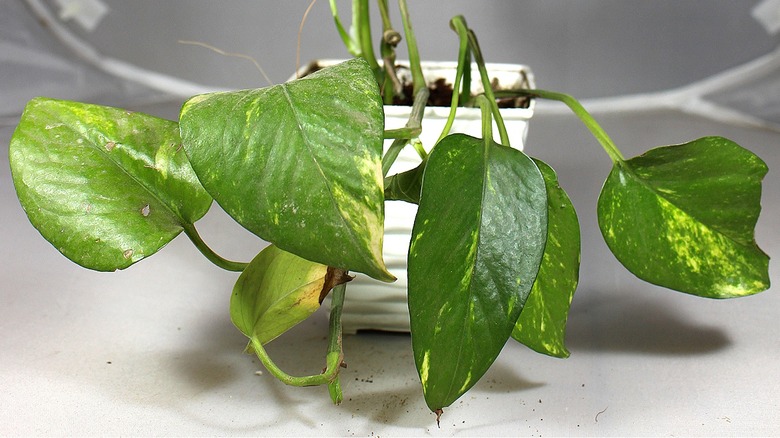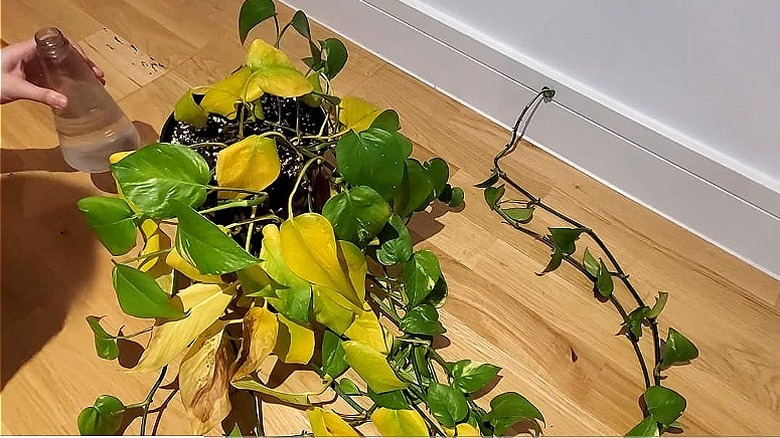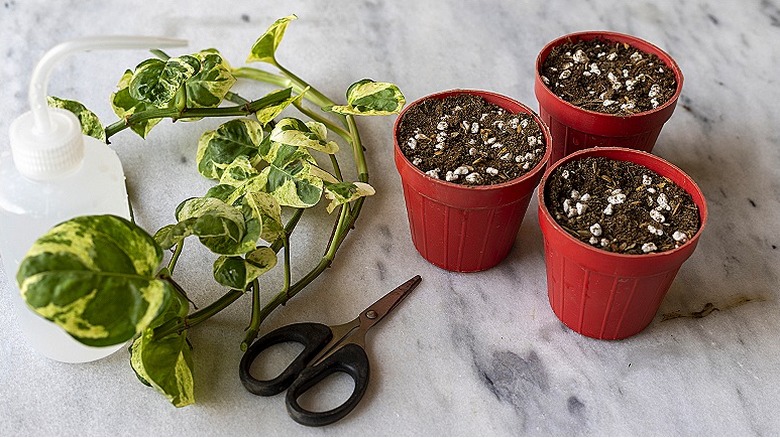What Your Pothos' Droopy Leaves Are Telling You & How To Fix It
Ah, pothos plant — a close companion to nature lovers seeking to breathe life into their indoor spaces. Visually striking with their thick, bright, waxy, heart-shaped leaves, the indoor aesthetics of pothos have a persona that's hard to ignore. But you'll forgive the pothos' humble brag, given these plants can hold their green color year-round and their aerial roots — nature's little adventurers — can cling and scale horizontally or vertically across any available surface. However, with that said, there may come the day when a plant parent stumbles upon that horrific sight: The heart-shaped leaves of pothos, usually full of life are drooping instead, hanging soft and slouchy and making your majestic green companion seem weary and lifeless.
On to the pressing question, "Why is my pothos suddenly droopy?" Your indoor plants aren't staging a coup d'etat against your green thumb skills. Those wilting leaves are your pothos version of a misspelled, handwritten SOS message in a bottle, signaling a tapestry of issues.
It could be hydration issues, too much sunbathing (yes, even your plant can get a sunburn), low humidity, crowded roots feeling claustrophobic in a pot, pest infestations, or even the interference of a pesky fungus or bacteria. However, every problem signals an opportunity for growth. By resolving water woes, adjusting light exposure, finding that perfect balance for humidity, giving the roots some breathing room, and ridding your green friend of crawling or fungal invaders, you can get your pothos right back in the game.
More on why your pothos leaves are soft and droopy
Overwatering is like inviting your pothos to an eternal swimming party where the pool never drains. Amidst this ceaseless splash activity, the roots drown, the plant gasps for breath, and before you know it, droopy pothos leaves unfold. Even well-draining soils are hardly immune to this drenching debacle. On the other end, underwatering is akin to forcing your green guest into a grueling marathon under the scorching sun with a thimble-sized sip of water — the leaves dry out and may even turn a worrying shade of brown.
The sun is like that loud, overly cheerful morning person — fantastic in moderation but migraine-inducing when relentless. Similarly, dousing your pothos in direct sunlight can dry the soil to a crisp, reduce optimal humidity levels, and potentially burn those delicate leaves. Moving on, ever been cornered in a peak-hour subway train? That's your potted pothos with overcrowded roots. This stunts water and nutrient absorption, triggering the yellowing and drying of the leaves.
Pests like aphids, mealybugs, and spider mites are the uninvited guests at your pothos' dinner party, sucking the sap and weakening the plant, sending it into a wilting, drooping frenzy. Pair that with fungal and bacterial infections, and you get a plant starring in its wilted-leaf melodrama. Meanwhile, recent potting could cause transplant shock, much like trying to adjust after moving to a new house without warning. Finally, wilted pothos performances, sometimes complemented by brown leaf spots, often signal too low humidity.
How do you fix a droopy pothos plant?
An underwatered, drooping pothos plant is like a cheerleader without pompoms — as sapped as a sloth post-lunch. Rejuvenation is hidden in soaking that parched green companion for 30 to 60 minutes in a sink filled with 4 inches of lukewarm water. But how do you fix an overwatered pothos? Simple: Uproot it and replace the waterlogged soil with a well-draining potting mix. A sprinkle of perlite might be the additional secret ingredient for proper aeration and drainage. And if your green friends pull a sunburnt vampire act? Relocate them to a location well-lit yet safe from direct sunlight. To alleviate root-bound, repot the plant in a spacious, well-draining container about 2 to 3 inches larger than the original pot.
Running water on your pothos can help evict critters. But if this doesn't settle your score, rubbing alcohol, insecticide soap, or neem oil might be your best bet for a fix. A fungicide is an obvious option for fungal infection. But if you want to keep things organic or dislike fungicide's distinctive smell? Consider an apple cedar vinegar solution. Pothos leaves drooping after repotting, albeit with proper care, is only a classic case of transplant shock. Here, it's a matter of giving the transplant time to adjust to its new surroundings. And if the ambiance is too dry? Grouping your plants (also a way to make your pothos seem fuller) or using a pebble tray or even a humidifier can provide the tropical pleasure your pothos crave.


